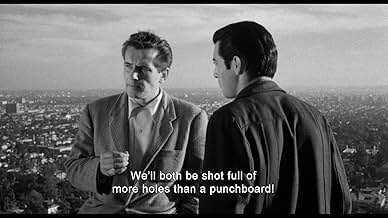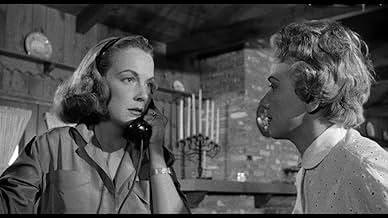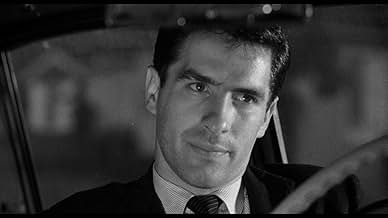IMDb-BEWERTUNG
6,3/10
1154
IHRE BEWERTUNG
Füge eine Handlung in deiner Sprache hinzuA group of convicted felons take over a suburban house to escape the ongoing police manhunt, turning the life of the family living there into a nightmare.A group of convicted felons take over a suburban house to escape the ongoing police manhunt, turning the life of the family living there into a nightmare.A group of convicted felons take over a suburban house to escape the ongoing police manhunt, turning the life of the family living there into a nightmare.
Eddie Marr
- Captain Cole
- (as Edward Marr)
Stanley Andrews
- Mr. Courtier
- (Nicht genannt)
Tom Coleman
- Reporter
- (Nicht genannt)
Oliver Cross
- Detective
- (Nicht genannt)
Roy Damron
- Detective
- (Nicht genannt)
Charles Herbert
- Steven Courtier
- (Nicht genannt)
Empfohlene Bewertungen
The Night Holds Terror doesn't have a whole lot going for it except for tension but maybe that's enough. Like Detour (which may be a distant ancestor), it's the story of how a whim, a twist of fate, can turn lives upside down. Driving home from his job at Edwards Air Force Base, Jack Kelly picks up a hitch-hiker (Vince Edwards) who pulls a gun on him. The rest of Edwards' gang (John Cassavettes and David Gross) join up, but spare Kelly's life when he has only 10 bucks on him. Deciding that trading in his car for cash is a better deal, they take over Kelly's knotty-pine home he has a wife (Hildy Parks) and two kids until the following day.
From then on in it's a standard family-held-hostage suspenser, with Edwards putting the moves on the wife and the inevitable sorting out of the pecking order among the gang members. When they depart next morning, taking Kelly along for insurance, Parks disobeys orders and calls the police. But will the police locate the gang before they kill Kelly?
His five years of glory as Ben Casey, M.D. still down the road, Edwards, smoldering and stretching the seams of his T-shirt, makes the strongest impression in the movie maybe the only impression. Cassavettes (occasionally looking like Jerry Lewis at about the same time) delivers an unremarkable performance, and the rest of the cast is no more than passable. Photography is the flat, 50s style until the end, when some night shots in driving rain add atmosphere. The story unfolds in the semi-documentary style common to its times, complete with voice-over narration (first by Kelly, then by an anonymous authority figure).
The Night Holds Terror gets compared frequently to The Desperate Hours, a better production but a stagier one as well. For all its low-budget look and low-price acting, the movie retains some authenticity. At times it almost seems like cinema-verité like those edgy little films Cassavettes himself would soon be making.
From then on in it's a standard family-held-hostage suspenser, with Edwards putting the moves on the wife and the inevitable sorting out of the pecking order among the gang members. When they depart next morning, taking Kelly along for insurance, Parks disobeys orders and calls the police. But will the police locate the gang before they kill Kelly?
His five years of glory as Ben Casey, M.D. still down the road, Edwards, smoldering and stretching the seams of his T-shirt, makes the strongest impression in the movie maybe the only impression. Cassavettes (occasionally looking like Jerry Lewis at about the same time) delivers an unremarkable performance, and the rest of the cast is no more than passable. Photography is the flat, 50s style until the end, when some night shots in driving rain add atmosphere. The story unfolds in the semi-documentary style common to its times, complete with voice-over narration (first by Kelly, then by an anonymous authority figure).
The Night Holds Terror gets compared frequently to The Desperate Hours, a better production but a stagier one as well. For all its low-budget look and low-price acting, the movie retains some authenticity. At times it almost seems like cinema-verité like those edgy little films Cassavettes himself would soon be making.
Gritty little suspenser that holds interest throughout. Writer-director Andrew Stone's and wife Virginia's reputation rests on a documentary-style approach to film-making. Making a movie about people on board a sinking ship?-- then sink an actual ship, The Last Voyage (1958). I believe it was Andrew Sarris who observed that it was a good thing they never made a film about the end of the world!
There's a lot of that documentary approach in this low-budgeter taken from an actual kidnapping case of the period. Kidnapping was much in the news in 1953 with the sensational abduction for ransom of little Bobby Greenlease, of Kansas City, I believe. And, of course, then as now, screen-writers love to chase the headlines of the day. So it's no surprise that several of these plot-lines turned up at about the same time, including the rather eerie Big House, USA (1955).
Here the screenplay recreates the abduction of the offspring of a wealthy LA-area family, Gene Couture. What makes the movie work is the inspired casting (probably a happy accident) that brings together three fast-rising young actors-- a sullen Vince Edwards, a moody John Cassavetes, and an appealing Jack Kelly as the victim. You really get the feeling from the former two-- who look edgy and act even edgier-- that anything can happen at any time. Together as the lead abductors, they're little short of the proverbial dynamite. When they take Kelly into the desert, you get the feeling he's a dead duck for sure.
Then too, the Stone's insistence on real suburban locations lends the proceedings a look and feel different from the usual. The procedural part gets kind of draggy as the cops enter the case and was likely inspired by the police mega-hit of the day, Dragnet. But at least it's consistent with the over-all documentary tone. Some buffs see the movie as noir. I don't, taking it instead as a particularly effective example of the "home invasion" genre that was also popular at the time. But however you cut it, this is still a darn good little 90 minute nail-biter.
There's a lot of that documentary approach in this low-budgeter taken from an actual kidnapping case of the period. Kidnapping was much in the news in 1953 with the sensational abduction for ransom of little Bobby Greenlease, of Kansas City, I believe. And, of course, then as now, screen-writers love to chase the headlines of the day. So it's no surprise that several of these plot-lines turned up at about the same time, including the rather eerie Big House, USA (1955).
Here the screenplay recreates the abduction of the offspring of a wealthy LA-area family, Gene Couture. What makes the movie work is the inspired casting (probably a happy accident) that brings together three fast-rising young actors-- a sullen Vince Edwards, a moody John Cassavetes, and an appealing Jack Kelly as the victim. You really get the feeling from the former two-- who look edgy and act even edgier-- that anything can happen at any time. Together as the lead abductors, they're little short of the proverbial dynamite. When they take Kelly into the desert, you get the feeling he's a dead duck for sure.
Then too, the Stone's insistence on real suburban locations lends the proceedings a look and feel different from the usual. The procedural part gets kind of draggy as the cops enter the case and was likely inspired by the police mega-hit of the day, Dragnet. But at least it's consistent with the over-all documentary tone. Some buffs see the movie as noir. I don't, taking it instead as a particularly effective example of the "home invasion" genre that was also popular at the time. But however you cut it, this is still a darn good little 90 minute nail-biter.
THE NIGHT HOLDS TERROR is an interesting thriller/film noir entry for various reasons. Yes, it bears a strong similarity to THE DESPERATE HOURS, but that's because both were inspired by the same true (and sensational) story. Proving which one went into production first might be difficult. But really, it doesn't matter, because unlike the Hollywood sheen of THE DESPERATE HOURS, this odd little film has many gritty aspects and colorings and transcends its low budget.
John Cassavetes is always great to watch, even in a lesser picture. Here, while he rarely truly shines, he manages to keep tightly wound like a coiled spring, with his menacing glare and occasional flashes of violence. Vince Edwards is actually nowhere near as good here as he was playing similar hoods in MURDER BY CONTRACT, CITY OF FEAR and THE KILLING, though it's an acceptably menacing performance.
What really makes THE NIGHT HOLDS TERROR is a constant reliance on real locations. I couldn't spot one studio set in the entire picture; every interior seems to be in a real place (Cassavetes' modern hilltop home and the Courtiers' kitchy suburban one, police stations, telephone switching centers, the Mojave desert, etc.). There is even one standout sequence where the captors' car careens through the desert, photographed by what appears to be a cameraman barely holding onto the hood of the car. No rear screen here, and this is several years before the famed from-the-hood Venice driving sequence in TOUCH OF EVIL.
And the pace of the picture is practically amphetamine-charged. If the camera isn't moving, the cast always is, with constant dialogue shot through with tension. This is a strong, underrated thriller, and while hardly a perfect masterpiece, it's definitely superior to stagier hostage dramas of the period and well worth tracking down.
John Cassavetes is always great to watch, even in a lesser picture. Here, while he rarely truly shines, he manages to keep tightly wound like a coiled spring, with his menacing glare and occasional flashes of violence. Vince Edwards is actually nowhere near as good here as he was playing similar hoods in MURDER BY CONTRACT, CITY OF FEAR and THE KILLING, though it's an acceptably menacing performance.
What really makes THE NIGHT HOLDS TERROR is a constant reliance on real locations. I couldn't spot one studio set in the entire picture; every interior seems to be in a real place (Cassavetes' modern hilltop home and the Courtiers' kitchy suburban one, police stations, telephone switching centers, the Mojave desert, etc.). There is even one standout sequence where the captors' car careens through the desert, photographed by what appears to be a cameraman barely holding onto the hood of the car. No rear screen here, and this is several years before the famed from-the-hood Venice driving sequence in TOUCH OF EVIL.
And the pace of the picture is practically amphetamine-charged. If the camera isn't moving, the cast always is, with constant dialogue shot through with tension. This is a strong, underrated thriller, and while hardly a perfect masterpiece, it's definitely superior to stagier hostage dramas of the period and well worth tracking down.
A gritty kidnapping caper (complete with no-nonsense, "Dragnet"-style narration) that turns into a documentary-style police procedural as the cops begin to close in. After a sensational beginning--featuring a carjacking, a home invasion, and a very terrified family--the movie begins to lose some steam in the second half (there are lots of shots of hard-working, real-life police dispatchers and telephone operators), but you'll still want to hang on till the end. With a very young John Cassavetes and a pre-"Ben Casey" Vince Edwards as two of the thugs. Based on actual events.
Enjoyed this 1955 film with great actors like Vince Edwards,( Victor Gosset) and John Cassavetes, (Robert Batsford) who were just starting their careers. In this picture Jack Kelly,(Gene Courtier) makes a very bad mistake and picks up a hitchhiker in the desert and Victor Gosset commanders his car and wants him to sell it for money and then meets up with Robert Batsford who is the boss of the kidnapping and then they decide to go to Gene Courtier home and hold his wife, Doris Courtier,(Hildy Parks) and two children hostage in their own home. Victor Gosset is crazy about women and can't seem to keep his hands off Doris Courtier and starts all kinds of problems with her husband. There is very high tension through out the entire picture and it was a great film for 1955. Enjoy
Wusstest du schon
- WissenswertesBased on a true story that happened in February 1953.
- PatzerIn the extended scene where Robert Batsford is in a telephone booth inside the Thrifty Drug Store, a member of the camera crew's reflection can be seen on the glass side throughout.
- Crazy CreditsThe five lead actors not only receive optical billing in the opening credits, but the narrator speaks both their actual names and their characters' names.
- VerbindungenFeatured in Los Angeles Plays Itself (2003)
- SoundtracksEvery Now and Then
Written by Virginia L. Stone (as Virginia Stone)
Top-Auswahl
Melde dich zum Bewerten an und greife auf die Watchlist für personalisierte Empfehlungen zu.
- How long is The Night Holds Terror?Powered by Alexa
Details
- Laufzeit1 Stunde 26 Minuten
- Farbe
- Seitenverhältnis
- 1.85 : 1
Zu dieser Seite beitragen
Bearbeitung vorschlagen oder fehlenden Inhalt hinzufügen

Oberste Lücke
By what name was Die Nacht ist voller Schrecken (1955) officially released in India in English?
Antwort



























